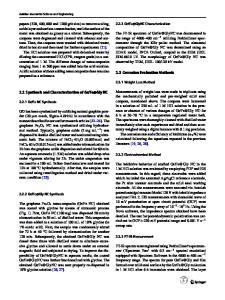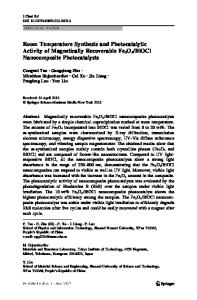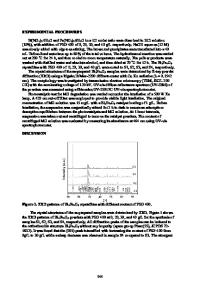Adsorptive and photocatalytic activity of Fe 3 O 4 -functionalized multilayer graphene oxide in the treatment of industr
- PDF / 5,926,037 Bytes
- 15 Pages / 595.276 x 790.866 pts Page_size
- 48 Downloads / 327 Views
ADVANCED OXIDATION/REDUCTION TECHNOLOGIES: AN PERSPECTIVE FROM IBEROAMERICAN COUNTRIES
Adsorptive and photocatalytic activity of Fe3O4-functionalized multilayer graphene oxide in the treatment of industrial textile wastewater Maryne Patrícia da Silva 1 & Ziani Santana Bandeira de Souza 1 & Jorge Vinicius Fernandes Lima Cavalcanti 1 Tiago José Marques Fraga 1 & Maurício Alves da Motta Sobrinho 1 & Marcos Gomes Ghislandi 1,2
&
Received: 15 June 2020 / Accepted: 17 September 2020 # Springer-Verlag GmbH Germany, part of Springer Nature 2020
Abstract Multilayer graphene oxide (mGO) was synthesized and functionalized via co-precipitation method to produce magnetic Fe3O4-functionalized multilayer graphene oxide nanocomposite (MmGO). Photocatalytic properties of MmGO were investigated in the photodegradation of raw textile wastewater samples. Fourier-transformed infrared spectroscopy revealed Fe–O vibrations, characterized by the band shift from 636.27 to 587.25 cm−1 on MmGO. X-ray diffraction confirmed the successful oxidation of graphite by the (002) peak at 10° and indicated the presence of Fe3O4 on MmGO surface by the peaks at 2θ 35.8° (311), 42.71° (400), 54.09° (511), and 62.8° (440). There was no detection of coercivity field and remnant magnetization, evidencing a material with superparamagnetic properties. Then, the textile effluent was treated by heterogeneous photo-Fenton (HPF) reaction. A 22 factorial design was conducted to evaluate the effects of MmGO dosage and H2O2 concentration on HPF, with color and turbidity removal as response variables. The kinetic behavior of the adsorption and HPF processes was investigated separately, in which, the equilibrium was reached within 60 and 120 min, for adsorption and HPF, respectively. Pseudo-second-order model exhibited the best fit, with COD uptake capacity at equilibrium of 4094.94 mg g−1, for chemical oxygen demand. The modeling of kinetics data showed that the Chan and Chu model was the most representative for HPF, with initial removal rate of 95.52 min−1. The removal of organic matter was 76.36% greater than that reached by conventional treatment at textile mills. The presence of Fe3O4 nanoparticles attached to MmGO surface was responsible for the increase of electron mobility and the enhancement of its photocatalytic properties. Finally, MmGO presented low phytotoxic to Cucumis sativus L. with a RGI of 0.53. These results bring satisfactory perspectives regarding further employment, on large scale, of MmGO as nanocatalyst of textile pollutants. Keywords Adsorption . Advanced oxidative processes . Functionalized graphene oxide . Magnetic 2D nanomaterial . Photo-Fenton . Phytotoxicity . Real textile wastewater
Responsible Editor: Sami Rtimi * Tiago José Marques Fraga [email protected] 1
Department of Chemical Engineering, Federal University of Pernambuco (UFPE), 1235 Prof. Moraes Rego Av., Cidade Universitária, Recife, PE 50670-901, Brazil
2
Engineering Campus–UACSA, Federal Rural University of Pernambuco (UFRPE), 300 Cento e Sessenta e Três Av, Cab
Data Loading...











